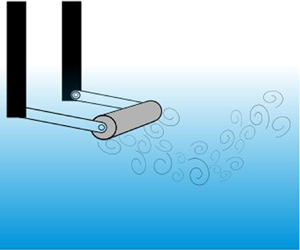Article contents
Fluid–structure interactions of a circular cylinder in a stratified fluid
Published online by Cambridge University Press: 25 March 2021
Abstract

In this article, the objective is to characterize the influence of a continuous stratification on wake-induced vibrations of a circular cylinder. Experimental results are obtained by towing a horizontal cylinder in a horizontal direction perpendicular to its axes, at a constant speed in a linearly stratified fluid made of salty water. The cylinder can move vertically since it is fixed to free-to-rotate arms. The diameter of the cylinder, the length of the arms and the translating speed are varied. Two flow-induced vibrations modes are observed. The first one is analogous to a vortex-induced vibration (VIV) mode: it is associated with a resonance between the vortex shedding frequency and its frequency is proportional to the natural frequency of the mechanical system, as can be predicted by the VIV theory generalized to low mass ratios. Large amplitude oscillations of the cylinder are found to occur in a large range of velocities also in agreement with the low-mass-ratio VIV theory. The second mode is interpreted as a galloping mode. It has a low frequency and a large amplitude, and occurs for low Froude numbers and long arms. It corresponds to the regimes when the buoyancy forces are larger than the inertial and vertical drag forces. By computing the forces on the cylinder, it is shown that stratification is the source of a destabilizing lift when the cylinder departs from its horizontal motion. Only a weak effect of the Reynolds number on the stability characteristics has been observed in the considered range ( $500 < Re < 15\,000$).
$500 < Re < 15\,000$).
JFM classification
Information
- Type
- JFM Papers
- Information
- Copyright
- © The Author(s), 2021. Published by Cambridge University Press
References
REFERENCES
- 6
- Cited by


